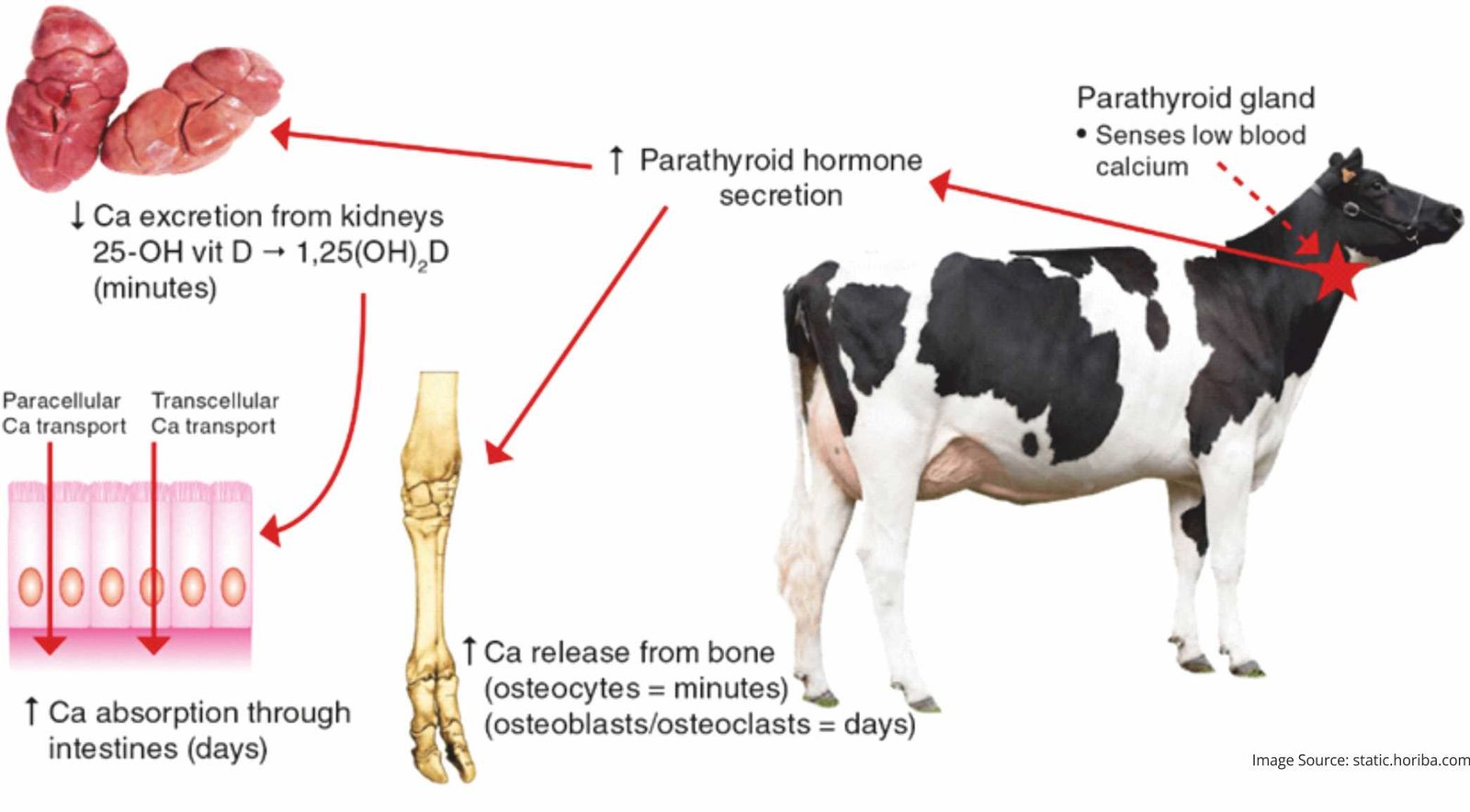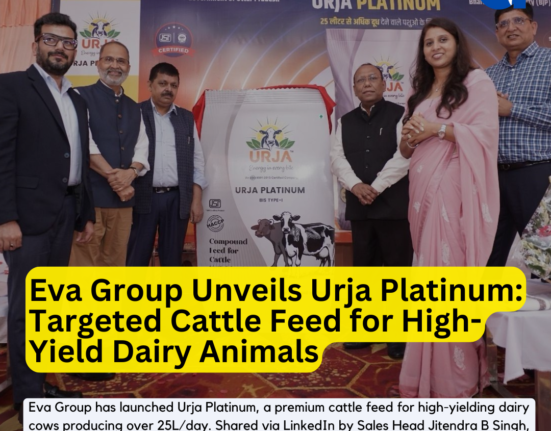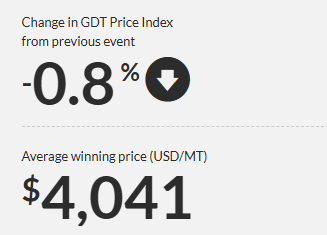Abstract
 Calcium metabolism during the periparturient period plays a crucial role in the health and productivity of dairy cows. The sudden surge in calcium demand for colostrum and milk synthesis immediately after calving often exceeds the body’s homeostatic capacity, predisposing cows to both clinical and subclinical hypocalcemia. These disorders not only compromise animal health but also negatively impact fertility, milk production, and overall farm profitability. This review examines the physiological basis of calcium dynamics in post-parturient dairy cows, assesses the consequences of impaired regulation, and discusses practical strategies for its prevention and management. A thorough understanding of these mechanisms is essential for maintaining the productivity and welfare of high-yielding dairy herds.
Calcium metabolism during the periparturient period plays a crucial role in the health and productivity of dairy cows. The sudden surge in calcium demand for colostrum and milk synthesis immediately after calving often exceeds the body’s homeostatic capacity, predisposing cows to both clinical and subclinical hypocalcemia. These disorders not only compromise animal health but also negatively impact fertility, milk production, and overall farm profitability. This review examines the physiological basis of calcium dynamics in post-parturient dairy cows, assesses the consequences of impaired regulation, and discusses practical strategies for its prevention and management. A thorough understanding of these mechanisms is essential for maintaining the productivity and welfare of high-yielding dairy herds.
Introduction
Calcium (Ca) is a vital macromineral involved in numerous physiological processes, including bone formation, nerve conduction, muscle contraction, and blood clotting. In dairy cows, calcium becomes especially critical during the periparturient period due to the sudden onset of lactation. The abrupt increase in calcium demand for colostrum and milk synthesis often exceeds the body’s immediate capacity for mobilisation and absorption, leading to hypocalcemia.
formation, nerve conduction, muscle contraction, and blood clotting. In dairy cows, calcium becomes especially critical during the periparturient period due to the sudden onset of lactation. The abrupt increase in calcium demand for colostrum and milk synthesis often exceeds the body’s immediate capacity for mobilisation and absorption, leading to hypocalcemia.
Post-parturient hypocalcemia, commonly referred to as “milk fever,” has long been recognised as a disorder affecting high-yielding cows. However, recent research suggests that subclinical hypocalcemia—though not visibly apparent—may be far more prevalent and equally detrimental. Its hidden impacts on feed intake, immune function, and reproductive performance underscore the need for a deeper understanding of calcium dynamics to design effective preventive strategies.
Physiology of Calcium Homeostasis
Calcium homeostasis in dairy cows is tightly regulated through a complex interplay of hormones and tissues. The key regulatory mechanisms include:
- Parathyroid Hormone (PTH): Secreted in response to declining blood calcium, PTH stimulates bone resorption, enhances renal calcium reabsorption, and increases synthesis of active vitamin D.
- 1,25-Dihydroxyvitamin D (Calcitriol): Produced in the kidneys under the influence of PTH, calcitriol enhances intestinal absorption of dietary calcium.
- Calcitonin: Secreted from the thyroid gland, calcitonin counteracts PTH by inhibiting bone resorption during calcium excess.
In the immediate postpartum period, the outflow of calcium into milk can exceed 30–40 g/day, placing immense stress on these homeostatic systems. The speed and efficiency with which cows adapt determines whether they remain normocalcemic or develop clinical or subclinical hypocalcemia.
Factors influencing hypocalcemia risk include:
- Parity: Multiparous cows are at greater risk due to reduced bone resorption efficiency.
- Breed: Jersey cows are more susceptible compared to Holsteins.
- Diet: High dietary cation-anion difference (DCAD) diets predispose cows to hypocalcemia, while controlled prepartum calcium intake enhances adaptation.
- Genetics: Genetic predisposition to milk fever has been documented, with heritability estimates being low but significant.
- Environmental stressors, including heat stress, overcrowding, and poor transition cow management, exacerbate the risk.
Globally, the prevalence of clinical hypocalcemia ranges from 3% to 10%, while subclinical hypocalcemia may affect up to 50% of multiparous cows in early lactation.
Clinical and Subclinical Hypocalcemia: Differentiating Impacts
- Clinical Hypocalcemia (Milk Fever): Characterised by recumbency, muscle weakness, cold extremities, and potentially coma if left untreated. Immediate intravenous calcium therapy is required.
- Subclinical Hypocalcemia (SCH): Defined as blood calcium <2.0 mmol/L without obvious clinical signs. SCH leads to immunosuppression, reduced dry matter intake, and increased risk of secondary disorders such as ketosis, displaced abomasum, mastitis, and impaired fertility.
While clinical cases are more visible, SCH imposes a far greater hidden economic burden by reducing herd productivity and longevity.
Economic Implications
The economic cost of hypocalcemia extends far beyond treatment expenses. It includes:
- Reduced milk yield in the subsequent lactation
- Increased incidence of secondary disorders (e.g., metritis, mastitis)
- Impaired reproductive performance and prolonged calving intervals
- Higher culling rates of affected cows
Preventive and Management Strategies
Effective management of hypocalcemia requires a multifaceted approach:
Nutritional Interventions
- Low-Calcium Diets Prepartum: Feeding diets containing <20 g Ca/day promotes increased sensitivity to PTH, reducing risk at calving.
- DCAD Manipulation: Feeding diets with a negative DCAD (via anionic salts) induces mild metabolic acidosis, improving calcium mmobilisation
- Magnesium Supplementation: Adequate Mg intake is essential for optimal PTH receptor responsiveness.
- Postpartum Calcium Supplementation: Oral calcium boluses immediately after calving can help prevent relapse in high-risk cows.
Genetic and Breeding Approaches
- Selective breeding for cows with greater resilience in calcium homeostasis
- Use of genomic markers associated with reduced susceptibility to hypocalcemia
Precision Livestock Farming (PLF) Tools
- Real-time monitoring of blood calcium using biosensors
- Activity and rumination sensors to detect early signs of hypocalcemia
- Automated supplementation systems integrated with precision dairy management
Therapeutic Advances
- Intravenous calcium gluconate remains the standard treatment for clinical cases.
- Controlled-release oral calcium formulations enhance efficacy and compliance.e
- Emerging use of novel feed additives (e.g., plant bioactives, probiotics) to improve mineral metabolism
Emerging Research and Innovations
Recent advances in dairy science are paving the way for novel solutions:
- Nanotechnology-Based Mineral Delivery: Nano-calcium formulations may enhance bioavailability.
- Microbiome Modulation: The gut microbiota influences calcium absorption; probiotics and prebiotics hold promise in this area.
- Endocrine Modulators: Continued research focuses on optimising PTH and calcitriol activity.
- Digital Twins and AI Models: Simulations of cow physiology help predict hypocalcemia risk and customise interventions at both herd and individual levels.
Implications for Dairy Sustainability
Effective calcium management is not only a matter of animal health but also one of long-term sustainability. Healthier cows experience fewer metabolic disorders, reducing drug use, lowering culling rates, and improving resource efficiency. These benefits align with global priorities for climate-smart and welfare-oriented dairy farming.
Future Directions
- Development of genetic lines with superior transition period resilience
- Wider adoption of PLF-based monitoring systems in commercial dairy operations
- Integration of nutrition, genetics, and data-driven decision-making models
- Strengthening extension services to improve farmer awareness and training
Conclusion
Calcium dynamics in post-parturient dairy cows represent a cornerstone of effective transition cow management. While clinical milk fever has long been recognised, the hidden burden of subclinical hypocalcemia continues to undermine dairy herd health and productivity worldwide. Advances in nutrition, genetics, technology, and precision livestock farming offer powerful tools to mitigate this risk. Ultimately, a holistic approach—integrating preventive strategies, farmer education, and scientific innovation—is essential to enhance cow resilience, safeguard productivity, and ensure the sustainability of the global dairy industry.
By Dr. Pawar Rutik Namdev & Dr. Shipra Tiwari, MVSc. Scholar, Department of Livestock Products Technology, College of Veterinary Science and Animal Husbandry, DUVASU Mathura







